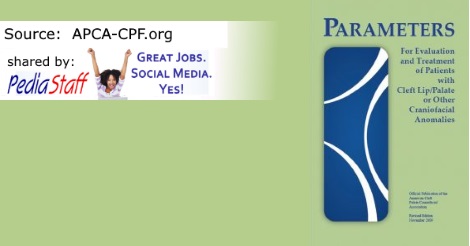SLP Corner: Parameters of Care – Cleft Lip/Palate
Editor’s Note: July is National Cleft & Craniofacial Awareness & Prevention Month! To learn more, visit NCCAPM.org for an excellent collection of organizations and resources on these conditions which affect thousands of infants, children, teens and aduts in the US every year.
[Source; The American Cleft Palate – Craniofacial Association]

There are numerous types of congenital craniofacial anomalies, the most common of which is cleft lip and/or palate. In the United States, this birth defect affects approximately one in 750 newborns each year. Approximately one-half of these infants have associated malformations, either minor or major, occurring in conjunction with the cleft (Jones, 1988; Rollnick and Pruzansky, 1981; Shprintzen et al., 1985). Although the incidence figures for more complex anomalies or syndromes such as Apert syndrome, Crouzon disease, mandibulofacial dysostosis or hemifacial microsomia are much lower than that for cleft lip and/or palate, the impact of craniofacial birth defects must be viewed in terms of the aggregate effect rather than the impact of any single entity. The impact is twofold:
Read/Download the Rest of this Publication on ACPA-CPF.org
PediaStaff is Hiring!
All JobsPediaStaff hires pediatric and school-based professionals nationwide for contract assignments of 2 to 12 months. We also help clinics, hospitals, schools, and home health agencies to find and hire these professionals directly. We work with Speech-Language Pathologists, Occupational and Physical Therapists, School Psychologists, and others in pediatric therapy and education.
